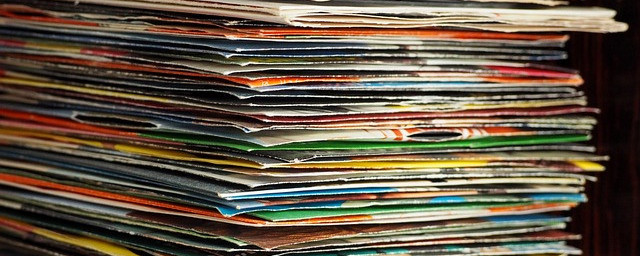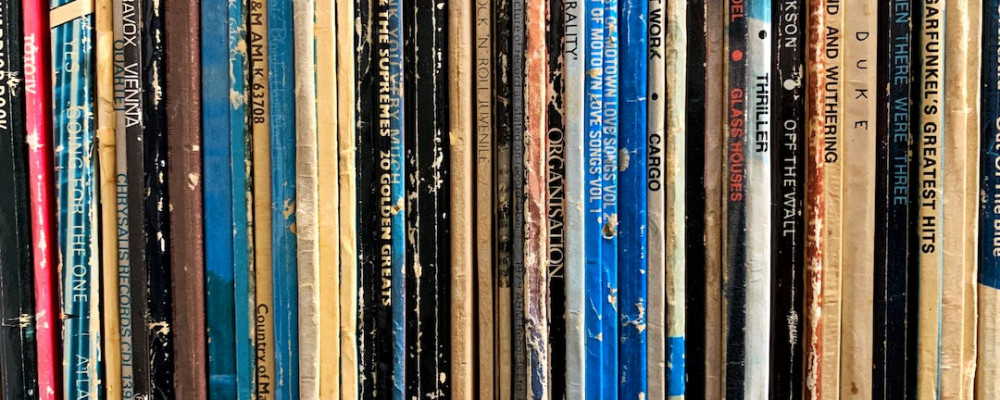
I think we can safely agree that a tottering stack of vinyl is a recipe for disaster.
A vinyl record storage cabinet or cabinets is a much better solution for preserving and showcasing your cherished vinyl collection. It’s certainly better than stacking them in tottering piles.
As you might imagine, they come in a variety of designs, sizes, and materials, offering a blend of function and aesthetics for all you vinyl enthusiasts.
Bold statement incoming… vinyl records are perhaps the most stable physical sound recording formats ever devised. Unlike cassettes, with their miles of tightly wound tape and, not to mention, (boo, hiss!) CDs, vinyl has already proved that it will last for decades in the home environment if you look after it properly.
Here we are going to look at the key features of vinyl record storage cabinets to help you make an informed decision for your vinyl storage needs.
Design, look and feel
This is perhaps the most obvious question, but what does it look like? The only limit to the range of designs is what the human mind could conceive. They are available in sleek modern styles to vintage-inspired classics. Obviously, any such cabinet that you purchase is going to have to meet with your personal taste and the existing decor of your space.
Although the sizes of an LP or a 45 are pretty much fixed, cabinets will feature adjustable shelving, allowing you to customize the layout to accommodate vinyl records of different sizes. The aesthetic appeal of these cabinets contributes to creating an inviting and organized vinyl collection display.
One of your decisions regarding the type of cabinet that you buy will be whether to buy something brand-new or instead to consider purchasing a vintage cabinet. From the heyday of vinyl records in the sixties and seventies, there is a great range of cabinets available for you to buy.
All of the usual places online, such as eBay, Etsy, Gumtree etc all have a great range of vintage and retro cabinets for you to peruse.
Materials and standard of construction
Cabinets can be made from many different hardwoods, such as oak, walnut, mahogany, maple, cedar, or cherry. When made using traditional methods, they will offer a combination of superior sturdiness and timeless aesthetics. Softwoods, such as pine can also be used to good effect.
Not only will your chosen wood have a significant impact on the durability and longevity of your cabinet, but it will also add greatly to the aesthetic of the finished product.
A little more affordable perhaps, but less aesthetically pleasing is MDF (Medium-Density Fibreboard). A cabinet made from this will, if well-constructed, prove durable. Cabinets can include protective finishes which will guard against moisture and UV rays, preserving the condition of your vinyl records.
Metal is generally not a good idea for a record storage cabinet. Whilst of course, it is strong, metal does tend to have sharper edges than wood. Metal also lacks the warmth of wood. For me, anyway.
Capacity and arrangement of the space
Obviously, vinyl collections vary in size and the best bit is, they are all likely to be growing 😉 As a result, it is important to consider the storage capacity of a cabinet. They can range from accommodating around a hundred to thousands of records.
Shelves can be adjustable or fixed, allowing vertical storage grouped together as 12-inch LPs, 10-inch discs or 45s. Your records should not be stored horizontally, stacked on top of each other as this may lead to them warping.

As a rule of thumb, LPs should be stored in groups of fifty which would necessitate a cube roughly 1 ft by 1 ft by 1 ft (1728 in2) or 30 x 30 x 30 = 2700 cm3. This amount of vinyl would weigh around 35 lbs or nearly 16 kg. As you can see, storing your vinyl is not an undertaking to be considered lightly.
Skilfully designed cabinets will have hidden depths in order that boxed sets or oversized vinyl editions can be accommodated. As a buyer, make sure you consider future expansion as well as your current collection. What? “No more records,” you say?
Access and organization
Efficient organization is a key factor when considering which vinyl record storage cabinet to buy. Those with dividers or compartments make it easier to categorize and access your collection by genre, artist, or any other criteria you could dream of.
You might consider a cabinet with a flip-forward design to allow easy flipping through your collection, just as if you were in a record store. Check, if you can, that any opening or closing mechanism is smooth. What about drawers and/or doors with magnetic closures to enhance access, but also to protect your records from dust?
Caring for your vinyl
Vinyl records are sensitive to environmental factors, so proper storage is essential for preserving their quality. Moisture can cause them to warp and become unplayable, so it is important to seek cabinets with proper ventilation to prevent moisture buildup.
UV-resistant glass doors or panels can shield your records from direct sunlight, reducing the risk of fading or warping. Although, of course, solid doors do much the same job.
Dust is always an issue with vinyl records too, so cabinets with snug-fitting doors and a good dust seal will help keep your vinyl collection dust free and therefore in good condition.
In terms of the location of your record cabinet(s) in the home, they should be situated away from direct heat sources such as a radiator. Equally, they should not be placed adjacent to a cold external wall.
Conclusion
Vinyl record storage cabinets offer a stylish and practical solution for organizing, displaying, and protecting your valuable vinyl collection. Not only that, but they will be a stylish addition to your household furniture.
In choosing a cabinet, you should take care to consider factors such as design, materials, storage capacity, ease of access, and protective features. Consider too the option of buying a vintage cabinet from the sixties or seventies.
For both the casual collector and the dedicated vinyl enthusiast, it is important to invest in a quality storage cabinet. This can only enhance the enjoyment and longevity of your collection of vinyl records.
All it remains for me to say now is please feel free to let me know your thoughts in the comments below. In particular, would you buy brand new or pre-loved?
